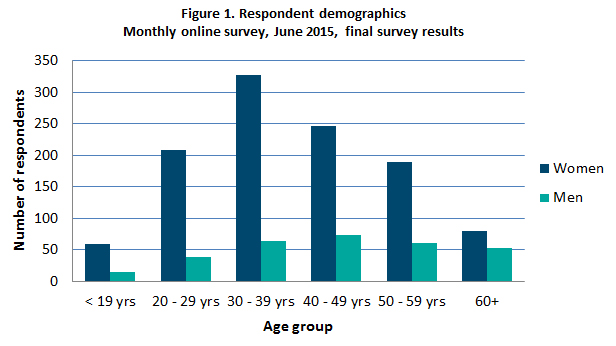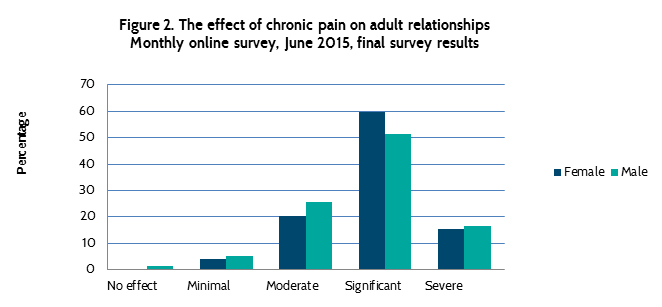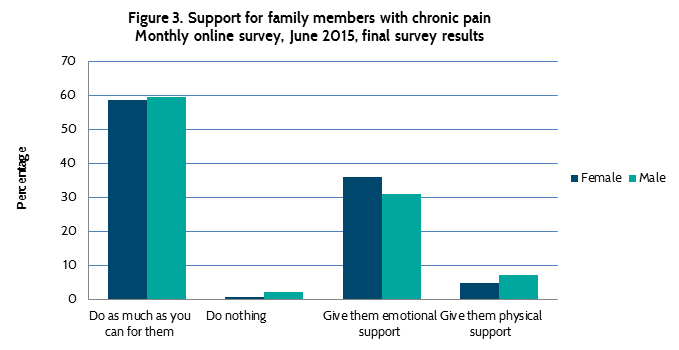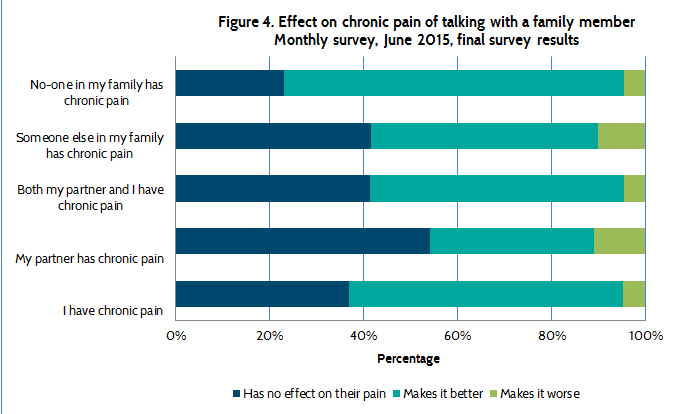Common effects of chronic pain include: depression, loss of sleep, loss of self-worth, loss of employment and how the sufferer is perceived by their family and peers. Chronic pain can also lead to social isolation, role tension, reduced sexual activity and feelings of anger, anxiety, resentment, and in some cases, suicide. Living with chronic pain can place a strain on relationships with partners, children, family, and friends
Introduction
Common effects of chronic pain include: depression, loss of sleep, loss of self-worth, loss of employment and how the sufferer is perceived by their family and peers. Chronic pain can also lead to social isolation, role tension, reduced sexual activity and feelings of anger, anxiety, resentment, and in some cases, suicide. Living with chronic pain can place a strain on relationships with partners, children, family, and friends.
Research suggests that positive relationships with family and friends can help pain suffers cope with their pain. In one study, patients who reported having non-supportive families tended to have higher levels of work-related injuries and reliance on medication, reported having more pain sites, and used more pain descriptors in describing their pain. Research also suggests that the extent to which chronic pain negatively affects the chronic pain sufferer’s respective partner and other family members was dependent to some extent on how effective the family was in coping with a relative with chronic pain.
The focus of Relationships Australia’s June online survey was to find out whether visitors to our website were affected by chronic pain, their attitudes to chronic pain and the effect of chronic pain on their relationships.
Previous research finds that…
- An estimated 20 per cent of adult Australians suffer chronic pain.
- More women than men experience chronic pain. Chronic pain is most common in women in the 50-54 age bracket and men in the 55-59 age bracket.
- Injury is the most common cause of chronic pain (38 per cent), though a further third of all people who experience chronic pain are unable to identify the original cause. Other identified causes include arthritis, musculoskeletal conditions, headache, cancer-related pain, post-surgical persistent pain and non-specific lower back pain.
- Chronic pain is estimated to cost the Australian economy $34.3 billion each year, which equates to $10,847 for each person with the condition.
Survey Results Analysis
More than 1450 people responded to the Relationships Australia online survey in June. Almost four-fifths of survey respondents (79%) identified as female.
As was the case for last month’s survey, more females than males responded in every age group (Figure 1). Eighty-five per cent of survey respondents were aged between 20‑59 years, with the highest number of responses collected for women aged between 30-39 years (inclusive).
The demographic profile of survey respondents remains consistent with our experience of the groups of people that would be accessing the Relationships Australia website.

Around one-third of male and female survey respondents reported that they have chronic pain, higher than the national average of 20 per cent. Just over 40 per cent of survey respondents reported that no-one in their family has chronic pain (see Table 1).
Table 1. Levels of chronic pain by gender, June 2015
|
|
Female
|
Male
|
|
I have chronic pain |
31 |
28 |
|
My partner has chronic pain |
|
12 |
|
Both my partner and I have chronic pain |
|
|
|
Someone else in my family has chronic pain |
15 |
11 |
|
No-one in my family has chronic pain |
41 |
45 |
|
Total |
100 |
100 |
Survey participants were asked about the effect of chronic pain on their adult relationships. Just over 95 per cent of respondents reported that they considered chronic pain to have a moderate to severe effect on adult relationships (Figure 2). Women were more likely to report significant to severe effects on adult relationships due to chronic pain than men (Women 75%, men 68%).

In response to the question, ‘If your family member has chronic pain, what do you think is the best way to support them?’ almost all survey participants indicated emotional support or doing as much as you can for them(Figure 3). Women were more likely than men to indicate a preference for emotional support (36% compared with 31%) and men more were more likely than women to report physical support (7% compared with 5%).

Men and women reported similarly when asked whether talking with a family member about their chronic pain had any effect on the pain. One-third (33%) of survey respondents reported that talking with a family member about their pain had no effect on the pain, while just under two-thirds (61%) reported that talking to a family member about their pain made the pain better.
Survey respondents who reported that no-one in their family was suffering chronic pain were more likely to indicate (72%) that talking to a family member about their pain made the pain better than other respondents. Where respondents indicated their partner has chronic pain, 54 per cent reported that talking with a family member has no effect on the pain (Figure 4) compared with 23 per cent for respondents who reported that no-one in their family has chronic pain.

References
BUPA Health Foundation Pain report, available at http://www.bupa.com.au/health-and-wellness/health-information/az-health-information/chronic-pain-fact-sheet
Jamison, R. N. and Virts, K. L. (1990). The influence of family support on chronic pain, Behaviour Research and Therapy, 28 (4), 283‑287
Acknowledgement/credits
Relationships Australia would like to acknowledge the assistance of Dr Toby Newton-John, University of Technology, Sydney in developing the questions for June’s monthly survey.
